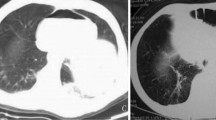Abstract
We defined injuries to the heart and the pericardium together with hemopericardium as pericardial tamponade type injury regardless of symptoms or signs due to pericardial tamponade. The aim of the study is to examine the important factors related to the diagnosis and treatment of this type of injury. A retrospective chart review was conducted of traumatized patients admitted with hemopericardium to our institution between 1978 and 1995. Ten out of the 19 consecutive patients with pericardial tamponade type injury demonstrated shock and showed a higher Injury Severity Score and mortality (7/11) than the remaining 9 without shock. The majority of our cases received an emergency room thoracotomy or a surgical fenestration and thereafter some of them needed a (re-)thoracotomy in the operating room. We consider a fenestration through the pericardium to be the first choice for the relief of acute hemopericardium due to trauma, while surgeons should not perform pericardiocentesis for the either diagnosis or relief of this type of injury.
Similar content being viewed by others
References
Tanaka H (1992) Chest trauma; a report of 596 cases (in Japanese with English abstract). Kyobu Geka (Jpn J Thorac Surg) 45:138–144
Bakers S, O’Neil B (1976) The injury severity score:an updatee. J Trauma 16:882-885
Follette DM (1994) Cardiac injury: contusion, tamponade, laceration, rupture, internal derangement, and foreign bodies. In: Blaisdell FW, Trunkey DD (eds) Trauma management Vol. III, cervicothoracic trauma, 2nd edn. Thieme, New York, pp 262–297
Trunkey DD (1988) Trauma care at mid-passage & a personal view-point: 1987 AAST presidential address. J Trauma 28:889–895
Moore EE, Malangoni MA, Cogbill TH, Shackford SR, Champion HR, Jurkovich GJ, McAninch JW, Trafton PG (1994) Organ injury scaling IV: thoracic vascular, lung, cardiac, and diaphragm. J Trauma 36:299–300
Moreno C, Moore EE, Majure JA, Hopeman AR (1986) Pericardial tamponade: a critical determinant for survival following cardiac injury. J Trauma 26:821–825
Permayer-Miulda G, Sagrista-Savleda J, Soler-Soler J (1985) Primary acute pericardial disease: a prospective study of 231 consecutive patients. Am J Cardiol 56:623–630
Ivatury RR (1996) Injury to the heart. In: Faliciano DV, Moore EE, Mattox KL (eds) Trauma, 3rd edn. Appleton and Lange, Stamford, pp 409–421
Jimenez E, Martin M, Krukenkamp I (1990) Subxiphoid pericardiotomy versus echocardiography: a prospective evaluation of the diagnosis of occult penetrating cardiac injury. Surgery 108:676–680
Tam VKH, Casale AS, Buchman TG (1990) Management of penetrating thoracic trauma. In Turney SZ, Rodriguez A, Cowley RA (eds) Management of cardiothoracic trauma. Williams and Wilkins, Baltimore, pp 285–309
Rodriguez A, Turney SZ (1990) Blunt injuries of the heart and pericardium. In: Turney SZ, Rodriguez A, Cowley RA (eds) Management of cardiothoracic trauma. Williams and Wilkins, Baltimore, pp 261–284
Author information
Authors and Affiliations
Rights and permissions
About this article
Cite this article
Tanaka, H., Fujita, T., Endoh, Y. et al. Pericardial tamponade type injury: A 17-year study in an urban trauma center in Japan. Surg Today 29, 1017–1023 (1999). https://doi.org/10.1007/s005950050638
Received:
Accepted:
Issue Date:
DOI: https://doi.org/10.1007/s005950050638




